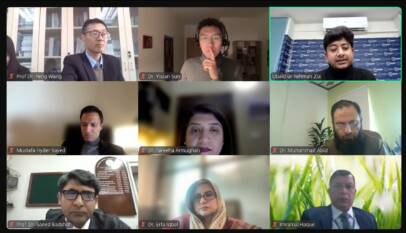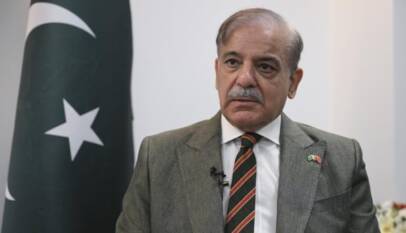Pak-China Industrial Cooperation Agreement to bring industrial revolution in Pakistan
Muhammad Azfar Ahsan, Chairman of Board of Investment (BoI) Pakistan writes that with the signing of the much-anticipated Framework Agreement on Industrial Cooperation during Prime Minister Imran Khan’s recent visit to China, CPEC has taken a quantum leap forward. He mentioned that the document was signed by none other than the Chairman of the National Development and Reforms Commission (NDRC) himself, from the Chinese side. He highlighted that as the second phase of the CPEC project kicks off, all eyes are on the rapid industrialization in the country. He added that BoI was set up with a view to promoting investments in all sectors of the economy. In 2016, the project’s apex decision-making body appointed the BoI and its Chinese counterpart NDRC as the lead agencies of the Joint Working Group on industrial cooperation. The modus operandi of this cooperation revolves around the development of the Special Economic Zones (SEZs) and the relocation of Chinese industries.
The China Pakistan Economic Corridor (CPEC) has witnessed a quantum leap with the signing of the much-anticipated Framework Agreement on Industrial Cooperation during Prime Minister Imran Khan’s recent visit to China.
I had the honour of signing the Framework Agreement on behalf of Pakistan. The significance of this document can be ascertained by the fact that the Framework signing was one of the top agendas put forward by the Chinese government with regards to the Prime Minister’s visit to China and it was signed by none other than the Chairman of National Development and Reforms Commission (NDRC) himself, from the Chinese side, which in itself testifies to the importance of this agreement because chairman NDRC is considered one of the top officials in this area. This move is also a testament to the avid earnestness of the Chinese in the high-quality development of the CPEC and negates the narrative of “slow-down” which has been associated with the project.
From Pakistan’s perspective, it goes without saying that the success of this flagship project of the ambitious Belt & Road Initiative (BRI) can only be gauged through the direct and indirect benefits it can bring to the country’s socio-economic development in the long run.
As the second phase of the CPEC project kicks off, all eyes are on the rapid industrialisation in the country. But, a few questions remain: How will industrial cooperation between the both sides steer CPEC’s future and will the dream of an industrialised, economically stable and prosperous Pakistan be realized.
The agreed-upon Framework Agreement is the first step of this long and arduous journey to transform the industrial landscape of Pakistan for which efforts have been made by the Federal Board of Investment (BoI). For an insight into the institutional mechanism of the CPEC project, it is imperative to understand the evolution of this landmark agreement and to evaluate the tangibility it would bring to Phase-II.
CPEC’s long-term plan — a comprehensive document comprising guiding principles of the win-win cooperation between Pakistan and China, was signed in 2017 and is effective till 2030. The philosophy of the phase-wise project management plan is in tandem with the vision of the two countries to achieve maximum objectives in a streamlined manner. Each phase of the project lays down the foundation for the next phase and eventually leads to the successful closure of the project.
In line with the long-term plan, the first phase of CPEC focused on improving the transport infrastructure in Pakistan and enhancing the power generation capacity, thereby forming the bedrock for Phase-II to commence.
Working together
BoI was set up with a view to promoting investments in all sectors of the economy, facilitating local and foreign investors, enhancing Pakistan’s international competitiveness, and contributing to economic and social development. So, it came as no surprise when in 2016, the project’s apex decision-making body known as Joint Cooperation Committee (JCC) appointed the BoI and its Chinese counterpart NDRC as the lead agencies of the Joint Working Group (JWG) on industrial cooperation.
The objective of the JWG is to attract Foreign Direct Investment (FDI), promote industrialisation and development of economic zones, and initiate, plan, execute and monitor projects in the public and private sectors.
As a part of this, it is expected that engagement with China will increase labor productivity in Pakistan, enhance industrial competitiveness, increase exports, and sustain diversification in the exports.
Economic zones and opportunities
The modus operandi of this cooperation revolves around the development of the Special Economic Zones (SEZs) and relocation of Chinese industries through effective business-to-business (B2B) matchmaking. Contrary to the Early Harvest CPEC projects which were executed on government-to-government (G2G) framework, the contours of industrial cooperation are widespread as it is of a business-to-business (B2B) nature and also open for third country participation, thereby multiplying the opportunities to attract hefty FDI in the SEZs from around the world.
The preliminary accomplishments of the JWG on industrial cooperation resulted in the consensus of cooperation in the establishment of nine SEZs across the corridor, technical and vocational training of local manpower, sector collaboration and policy matters pertaining to the Chinese investments in the SEZs.
However, the JWG was essentially lacking a goal-oriented roadmap that was vital to transform the notion of “what to achieve” into “how to achieve”. Therefore, to formulate a structured approach and to yield positive results from industrial cooperation BoI began the spadework on drafting a Framework Agreement that was shared with its Chinese counterpart in 2018.
But owing to the lack of timely consensus between both parties, this did not materialize. Instead, a Memorandum of Understanding (MoU) was signed during the 8th JCC meeting held in Beijing, the same year. This MoU was the first milestone achieved by both sides in formulating the short-term goals of the JWG.
With the signing of the MoU and as the scope of work to augment CPEC Industrial Cooperation gradually increased, BoI realized the shortage of regular staff to take charge of CPEC matters. Therefore, a dedicated Project Management Unit (PMU) was, established in 2019 under the Public Sector Development Programme (PSDP).
The PMU, which comprises a diligent team of young minds, assumed the role of a secretariat that operates under the administrative control of BoI for all matters pertaining to CPEC Industrial Cooperation. With the passage of time, it became evident that the MoU had become redundant in a way that it did not promise practical and pragmatic aspects of Industrial Cooperation. As CPEC entered its second phase which primarily revolves around SEZs development, industrialization, FDI generation, and stronger B2B ties between both sides, with special emphasis on industrial relocation from China, the need for a comprehensive Framework Agreement became imperative to achieve tangible outcomes through a predefined road map.
Similarly, experience has shown that deliberations with the Chinese without any baseline in the form of a framework, was like a shot in the dark. Therefore, with a renewed zeal, the PMU of BoI resumed their efforts to finalize the Framework with the NDRC in 2019 but remained unsuccessful once again.
It was only in early 2020, that both sides concurred on elevating the MoU on Industrial Cooperation into a Framework Agreement.
BoI took the lead and started afresh to draft the Framework Agreement based on the actual demands of industrialization in the country. Extensive consultations were carried out with an all-inclusive approach to involve public and private sectors, academia, and economic experts for shaping up this all-crucial document.
A one-day consultative forum was also held in Islamabad, whereby the concerned quarters were invited for a brainstorming session by BoI. After thorough deliberations and with the approval of the Prime Minister, the draft Framework Agreement was shared with the Chinese in November 2020 for its consideration and feedback. The year 2020 was marred by the Covid-19 pandemic that resulted in a shift in the government’s priorities that hampered inter-governmental coordination. However, to keep the matter alive, BoI remained steadfast in its resolve throughout 2021 and in this regard, all political and diplomatic channels were approached for meaningful interventions to expedite the matter for initiating the process of negotiations between the parties.
I, along with secretary (BoI) Fareena Mazhar, held several meetings with the Chinese ambassador to Pakistan, H.E. Nong Rong and Pakistan’s ambassador to China, H.E. Moin ul Haque, to address the matter which had been in abeyance for a considerable time.
The visit
Similarly, during the preparatory work for Prime Minister Imran Khan’s visit to China, the finalization of the Framework Agreement was also submitted to his office as one of the pertinent “asks” of BoI.
The announcement of the prime minister’s visit to China set in motion the negotiations with the Chinese whereby the feedback on the draft Framework Agreement shared by BoI in 2020 was first received from NDRC. With expeditious negotiations, the parties reached common ground on the contents of the accord which saw the light of the day on 4th February 2022, in the prime minister’s presence. The Framework Agreement on Industrial Cooperation will steer Pakistan into a new era of industrialization with an aim to enhance the multi-sector industrial competitiveness. Concrete commitments have been formalized through the agreement whereby the government of Pakistan will ensure all-out efforts for a conducive business environment and timely development of the SEZs.
The agreement reaffirms the prioritized development and operations of the nine SEZs, with a primary focus on the early completion of Rashakai SEZ in KP, Allama Iqbal Industrial City in Punjab, Dhabeji SEZ in Sindh, and Bostan SEZ in Balochistan. For colonization of these SEZs, the business-to-business matchmaking mechanism of Pakistani and Chinese enterprises has been emphasized which will also proliferate the people-to-people and institution-to-institution linkages.
Industrial cooperation
To execute beneficial projects that will rejuvenate the process of Industrial Cooperation, an understanding to establish a dedicated fund has been developed between the parties as well. As CPEC Industrial Cooperation is open for third country participation, effective marketing of these SEZs will also be carried out by both countries at the global level to attract investments from around the world. Besides this, due consideration has also been given to vocational training and employment of local manpower, including professionals in CPEC projects.
With the signing of the Framework Agreement on Industrial Cooperation, a world of business opportunities has opened where Pakistani enterprises can leverage technical and financial cooperation through joint ventures with Chinese businesses.
It would also proliferate the rapid development and colonization of the SEZs which have proven to be a successful economic model around the world. The role of governments in CPEC Phase-II is that of a facilitator whereas the private sector and business community would be the beneficiaries who can exploit the available opportunities under this new arrangement between China and Pakistan.
As Chinese industries are actively relocating to other parts of the world, it is high time for Pakistan to tap this opportunity and provide a favorable business environment that will bring the Chinese Outward Foreign Direct Investment (OFDI). This will result in the enhancement of industrial competitiveness, technology transfer, import substitution, export-led growth, human capital development, employment generation, and numerous other direct and indirect benefits to the economy.
Keeping in view the current economic challenges being faced by Pakistan and the geopolitical factors, it would be appropriate to say that the future of the strategic partnership between Pakistan and China will only bolster under CPEC Industrial Cooperation.
China has advantages in experience, technology, financing, and industrial capacity, while Pakistan enjoys favorable conditions in natural resources, adequate manpower, quality infrastructure, access to international markets, and optimal policies for industrial development. The economic interests of the two countries coincide in a quintessential manner under the Framework Agreement on Industrial Cooperation that will go a long way and beyond 2030.
Chinese Ambassador highlights significance of Third Plenary Session for China-Pakistan cooperation
The Third Plenary Session of the 20th Central Committee of the Communist Party of China ha…













